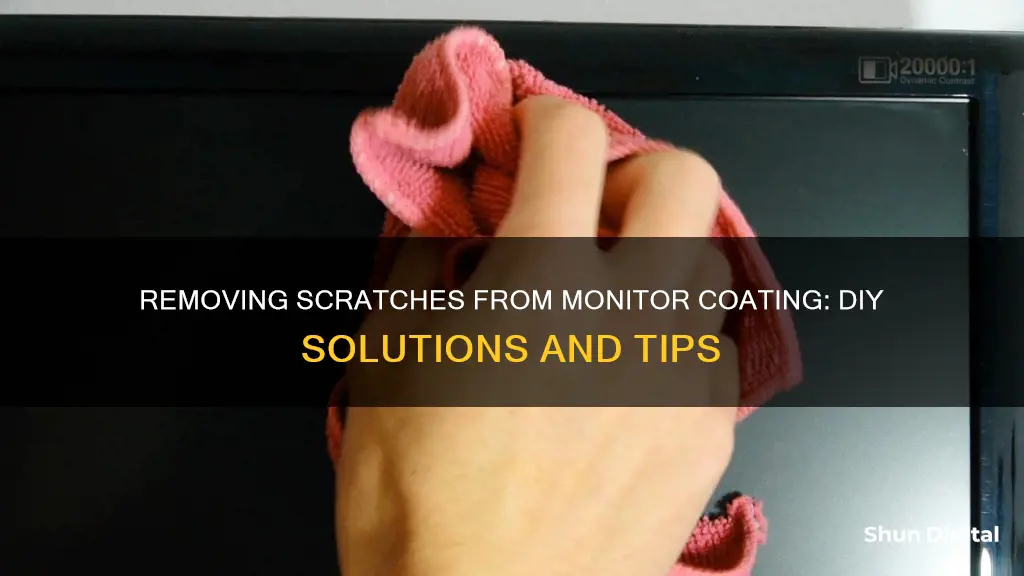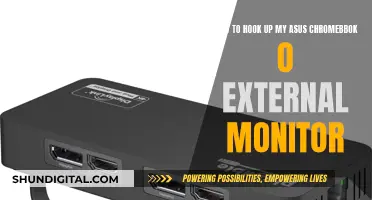
Scratches on a monitor can be frustrating, especially when they impact your viewing experience. While it may be tempting to reach for household products, not all of them are suitable for monitor screens and may end up doing more harm than good. Before attempting any scratch repair, it's important to assess the type of scratch and the coating of your screen, as different methods are suitable for different types of scratches and coatings. For example, some methods are only suitable for light scratches, while others can be used for deeper scratches. Additionally, certain products should not be used on screens with ARAG (anti-reflective, anti-glare) coatings.
Methods for Removing Scratches on Monitor Coating
| Characteristics | Values |
|---|---|
| Eraser | Use a soft rubber eraser or the type on the end of a pencil. Rub the scratch left and right for 60 seconds, then up and down for 60 seconds. |
| Isopropyl Alcohol | Apply alcohol evenly over the screen, being careful not to let it seep into the edges. Wipe down with a microfiber cloth and use cotton buds for stubborn spots. |
| Toothpaste | Clean the screen first, then apply an abrasive toothpaste with polishing properties. Use a cloth to rub it in a circular motion to polish the screen. |
| Vaseline | Gently rub Vaseline or any petroleum jelly-based cream into the scratch to help it blend in. Only works on matte plastic screens. |
| Windscreen or Glass Polish | Try automobile windscreen polish or plastic polish for deep scratches. |
| Fine Sandpaper | Use a wet piece of very fine sandpaper (2000 grit) in circular motions, then apply windscreen polish and car wax. |
| Banana and Baking Soda | Mash bananas and mix with baking soda. This method is untested but was historically used to repair scratched CDs. |
What You'll Learn

Using a soft eraser
Erasers are a common and easy way to remove scratches from your monitor. It is important to use a soft, rubbery pencil eraser, not a rough, abrasive type. Make sure the eraser is clean and free of graphite. Gently rub the eraser in the direction of the scratch for about 60 seconds, then rub it in the opposite direction for another 60 seconds. The friction softens the eraser, and it fills in the scratch. Be careful not to press down too hard.
It is also important to note that this method is only suitable for light scratches. If the scratch is too deep, you may need to purchase a new screen cover or take it to a professional for repair. Additionally, make sure to clean your screen before attempting any scratch repair to avoid rubbing residues into the scratches.
Ping and Resource Monitor: Key Differences Explained
You may want to see also

Applying isopropyl alcohol with a microfiber cloth
To remove scratches from your monitor coating, you can try using a professional scratch repair kit. However, if you want to apply isopropyl alcohol with a microfiber cloth, follow these steps:
Firstly, it is important to note that you should avoid using paper towels, tissues, or old t-shirts, as these can scratch your screen. Instead, opt for a soft, lint-free microfiber cloth. Power down your monitor and unplug it before you begin.
Next, take your isopropyl alcohol and microfiber cloth. It is recommended to use a 50/50 mixture of isopropyl alcohol and distilled water. Lightly dampen the cloth with the mixture, ensuring it is not overly wet.
Now, gently wipe the screen in circular motions, being careful not to apply too much pressure. You can also try using up-and-down motions across the screen, followed by drying it with the dry side of the cloth. Repeat the process if necessary.
Finally, allow the screen to air-dry completely before turning the monitor back on.
Note: It is generally not recommended to use isopropyl alcohol directly on a monitor screen, as it may damage the screen's protective coating. Always exercise caution and follow manufacturer guidelines when cleaning your monitor.
Removing the Red Target Symbol from Your AOC Monitor
You may want to see also

Using toothpaste with polishing properties
Toothpaste is a common household item that is often used as a quick fix for removing scratches from screens. It is important to note that toothpaste should only be used on plastic screen protectors and not directly on screens. While toothpaste can be effective at removing small surface scratches on plastic, deeper scratches that affect the display may require a more powerful solution.
- Power down your device: Scratches are easier to see when the screen is dark. Turn off your device to clearly identify the scratches.
- Choose the right toothpaste: Select a toothpaste that contains mild abrasives such as baking soda or hydrated silica. Avoid gel-based toothpastes as they may not be effective for scratch removal.
- Apply toothpaste to the scratch: Squeeze a small amount of toothpaste directly onto the scratch. Ensure that you only cover the affected area.
- Buff the scratch: Use a soft, clean cloth to gently buff the toothpaste into the scratch. Work the toothpaste into the scratch using gentle circular motions. Avoid pressing too hard, as this may damage the screen protector.
- Wipe away excess toothpaste: Use a soft, slightly damp cloth to wipe away any remaining toothpaste. Be sure to remove all traces of toothpaste from the screen protector.
- Review your results: Inspect the screen protector for any remaining scratches. If necessary, repeat the process until the scratches are no longer visible.
It is important to note that toothpaste should not be used on screens with an anti-reflective or anti-glare (ARAG) coating, as it can damage the coating and reduce its effectiveness. Additionally, toothpaste is not designed for use on glass surfaces due to its mild nature. If you are dealing with scratches on a glass screen, it is recommended to use a screen polish or scratch remover designed for glass.
The Oddity of Mismatched Monitor Setups: Sizing Differences
You may want to see also

Applying Vaseline or a petroleum jelly-based cream
Step 1: Clean the Screen
Before attempting to fill in the scratches, it is important to clean the screen thoroughly. Use a soft, microfiber cloth and gently wipe the screen with circular motions. Ensure that the cloth is slightly damp, but do not use tap water as it can leave deposits or streaks. Instead, opt for distilled or deionized water.
Step 2: Apply Vaseline
Once the screen is clean and dry, it's time to apply the Vaseline. Take a small amount of Vaseline or petroleum jelly-based cream on a clean finger or a Q-tip. Gently rub it into the scratch, ensuring that it fills the gap. It is recommended to do this with the monitor turned off and against a white background, as it will be easier to see the scratch.
Step 3: Remove Excess Vaseline
After applying the Vaseline, use a plastic razor blade or a lint-free cloth to gently remove any excess product from the screen. Be careful not to dig out the Vaseline from the scratch. This step will help ensure that the scratch remains filled while keeping the surrounding area clean.
Step 4: Assess the Results
Turn on the monitor and inspect the scratch. If the scratch is still noticeable, you may need to apply a little more Vaseline. Repeat the process until the scratch becomes less visible.
It is important to note that this method may not work for all types of screens. It is recommended for glossy screens, while it may not be effective for matte screens. Additionally, always ensure that you are gentle during the process to avoid causing further damage to the screen.
Recognizing HD Monitors: What to Look For
You may want to see also

Using windscreen or glass polish
Firstly, you will need to purchase a windscreen or glass polish. This may be costly, but it is a good option if you have deep scratches on your screen. You should also get a microfiber cloth if your polish kit doesn't include one. Microfiber cloths ensure that your screen doesn't get scratched during the buffing process.
Before you start, power down your monitor so that scratches are easier to see. Then, apply the polish to the scratch and the immediate area surrounding it. Take your microfiber cloth and gently buff the solution into the scratch. Keep doing this until the screen appears dry.
Make sure you don't let the liquids get into the edges of the screen, as this could destroy the electronics.
Monitoring Employee Internet Usage: Free, Easy, and Effective Ways
You may want to see also
Frequently asked questions
If the scratch is very light, you can try using a soft eraser, or a scratch repair kit. For deeper scratches, you may need to replace the screen or use a screen protector.
Yes, some people suggest using toothpaste (not gel), petroleum jelly, or windscreen polish. However, these methods may not be effective for all types of screens and may even cause further damage, so use them with caution.
To prevent scratches, it is recommended to use a screen protector. This will help keep your screen safe from scratches and other damage.
Avoid using abrasive solutions, solvents, or anything that is too harsh on the screen. Also, be careful not to get any liquids inside the edges of the screen, as this can damage the electronics.







